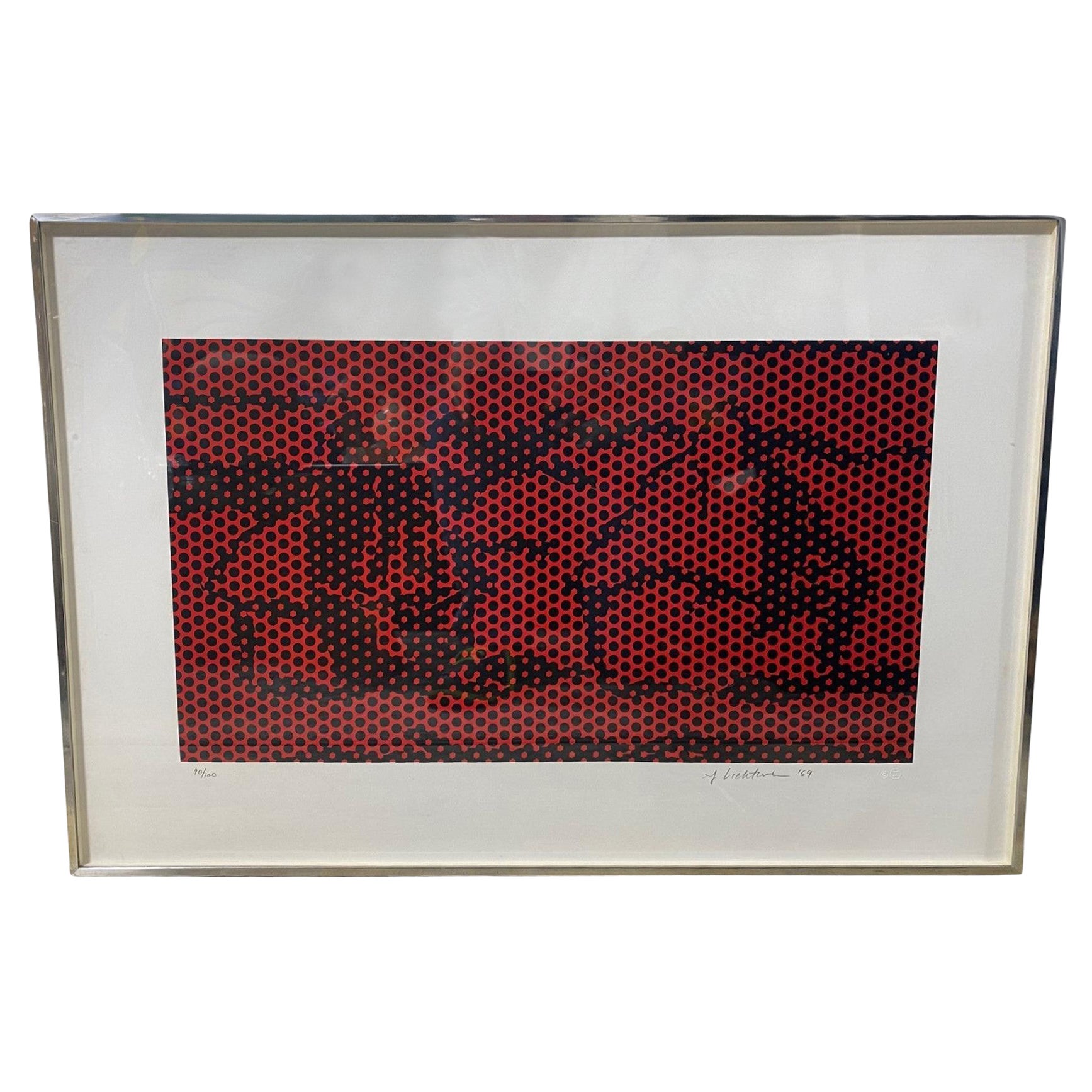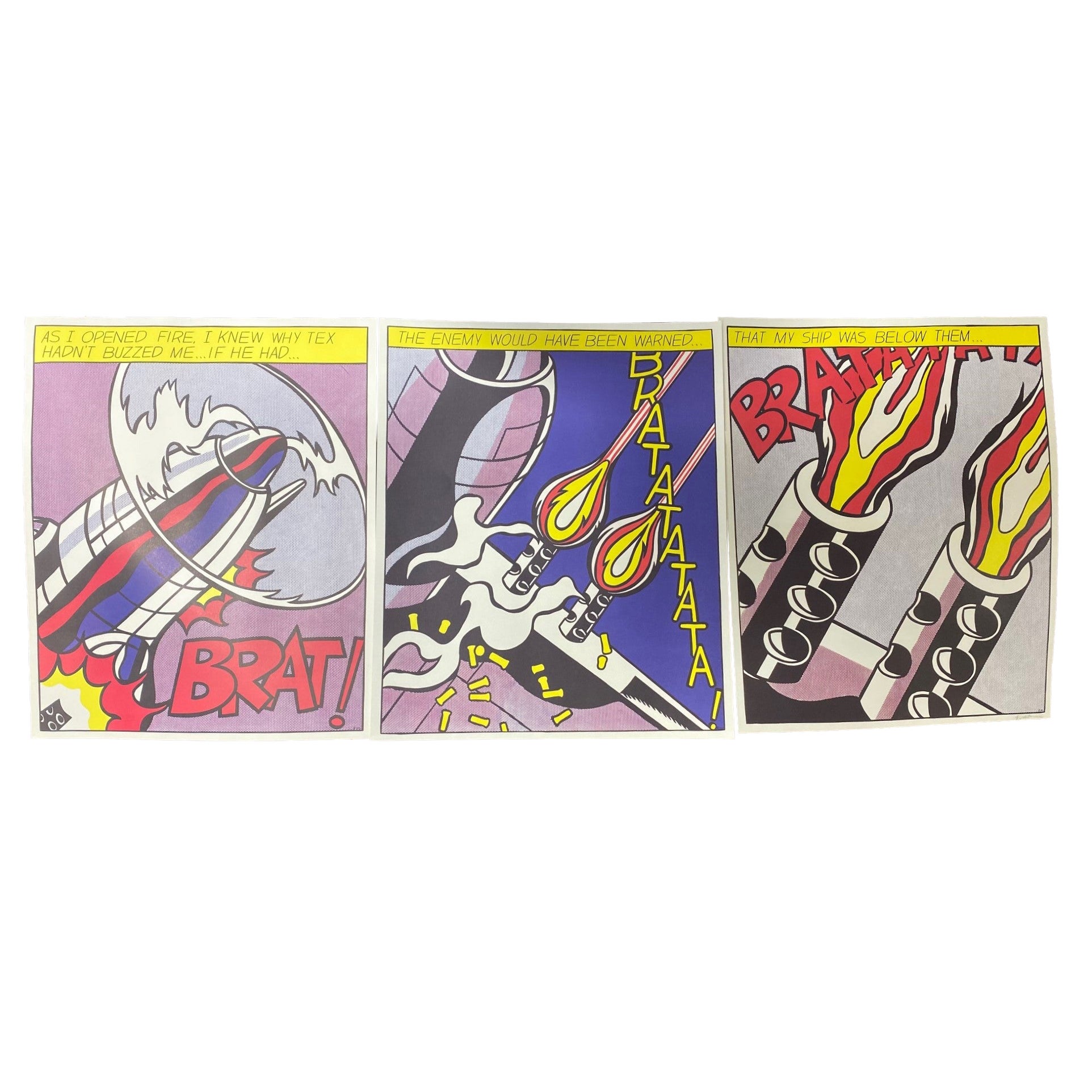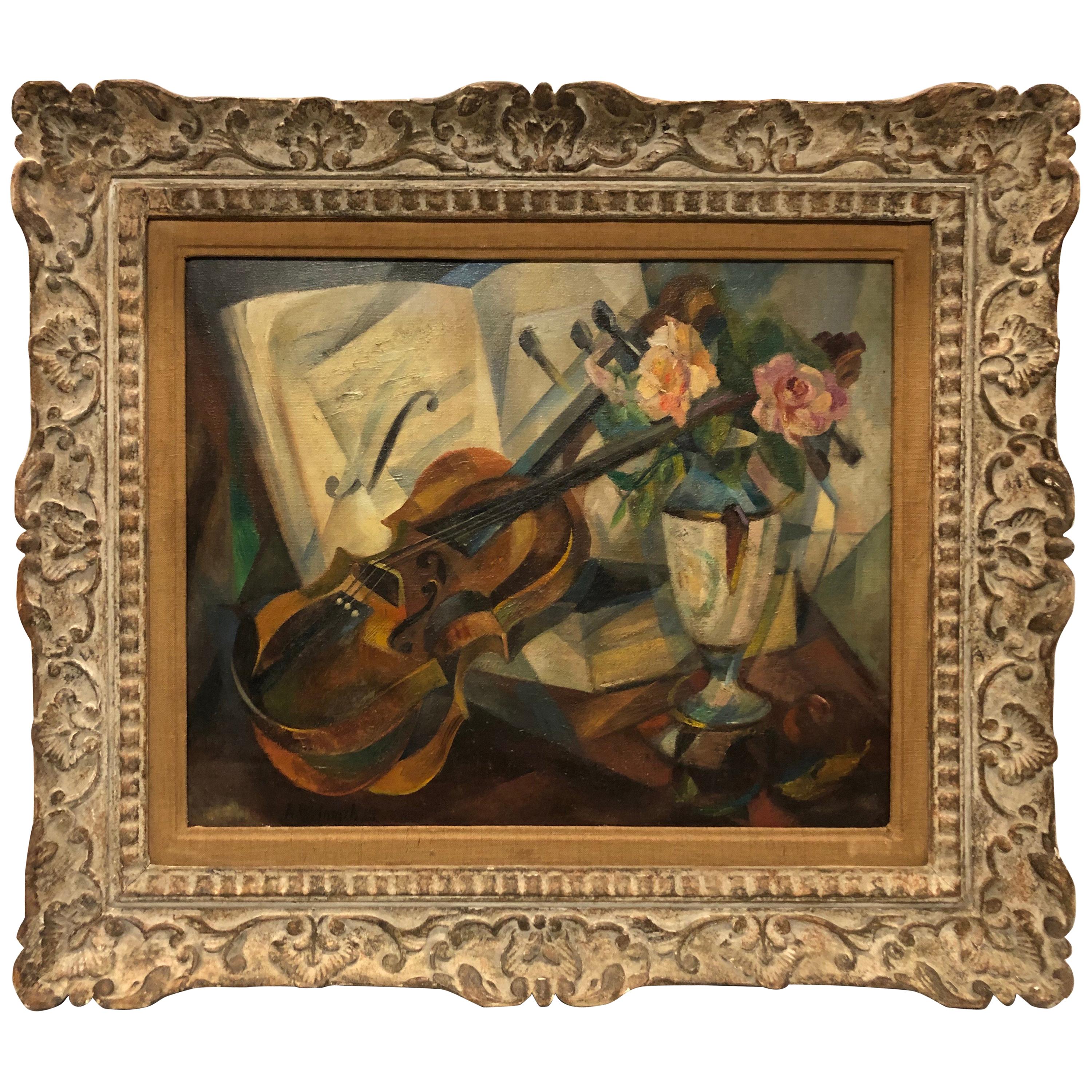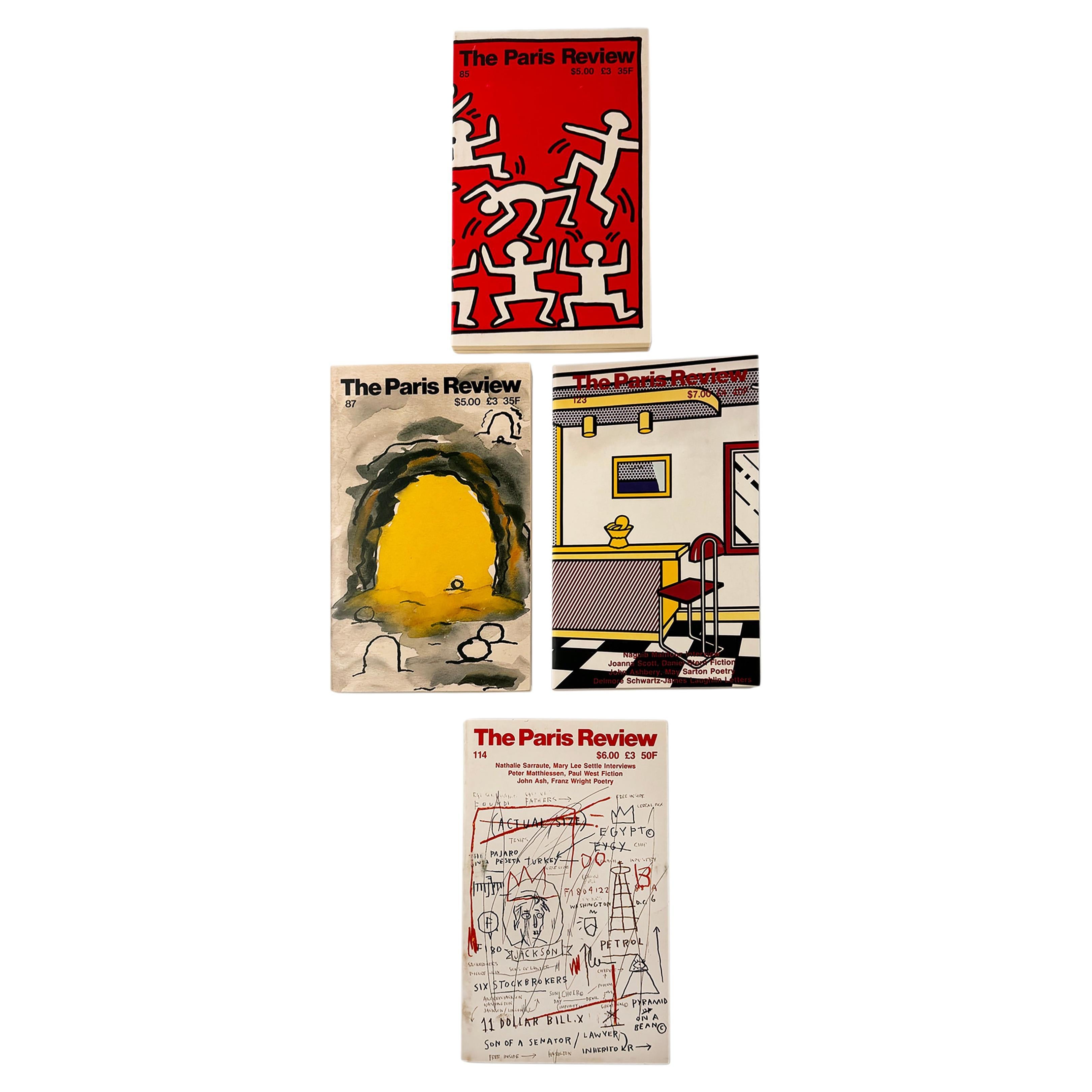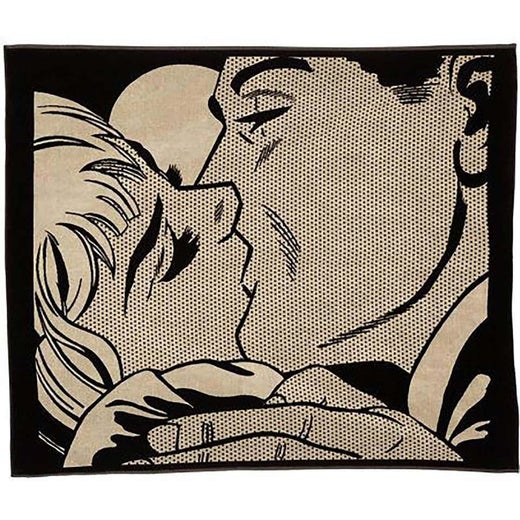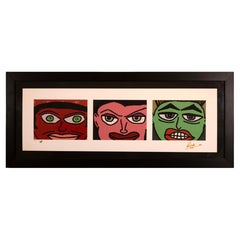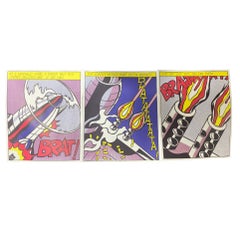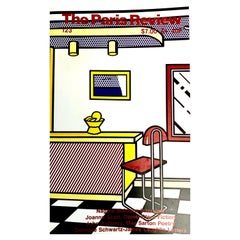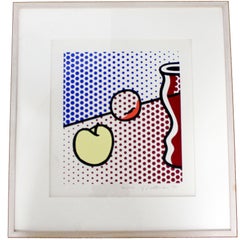
Contemporary Framed Still Life with Red Jar Signed Dated Roy Lichtenstein, 1994
View Similar Items
Contemporary Framed Still Life with Red Jar Signed Dated Roy Lichtenstein, 1994
About the Item
- Creator:Roy Lichtenstein (Artist)
- Dimensions:Height: 27 in (68.58 cm)Width: 25 in (63.5 cm)Depth: 2 in (5.08 cm)
- Place of Origin:
- Period:1990-1999
- Date of Manufacture:1994
- Condition:
- Seller Location:Keego Harbor, MI
- Reference Number:1stDibs: LU2715311949811
Roy Lichtenstein
Roy Lichtenstein is one of the principal figures of the American Pop art movement, along with Andy Warhol, James Rosenquist, Claes Oldenburg and Robert Rauschenberg.
Drawing inspiration from comic strips, Lichtenstein appropriated techniques commercial printing in his paintings, introducing a vernacular sensibility to the visual landscape of contemporary art. He employed visual elements such as the halftone dots that comprise a printed image, and a comic-inspired use of primary colors gave his paintings their signature “Pop” palette.
Born and raised in New York City, Lichtenstein enjoyed Manhattan’s myriad cultural offerings and comic books in equal measure. He began painting seriously as a teenager, studying watercolor painting at the Parsons School of Design in the late 1930s, and later at the Art Students League, where he worked with American realist painter Reginald Marsh. He began his undergraduate education at Ohio State University in 1940, and after a three-year stint in the United States Army during World War II, he completed his bachelor’s degree and then his master’s in fine arts. The roots of Lichtenstein’s interest in the convergence of high art and popular culture are evident even in his early years in Cleveland, where in the late 1940s, he taught at Ohio State, designed window displays for a department store and painted his own pieces.
Working at the height of the Abstract Expressionist movement in the 1950s, Lichtenstein deliberately eschewed the sort of painting that was held in high esteem by the art world and chose instead to explore the visual world of print advertising and comics. This gesture of recontextualizing a lowbrow image by importing it into a fine-art context would become a trademark of Lichtenstein’s artistic style, as well as a vehicle for his critique of the concept of good taste. His 1963 painting Whaam! confronts the viewer with an impact scene from a 1962-era issue of DC Comics’ All American Men of War. Isolated from its larger context, this image combines the playful lettering and brightly colored illustration of the original comic with a darker message about military conflict at the height of the Cold War. Crying Girl from the same year featured another of Lichtenstein’s motifs — a woman in distress, depicted with a mixture of drama and deadpan humor. His work gained a wider audience by creating a comic-inspired mural for the New York State Pavilion of the 1964 World's Fair, he went on to be represented by legendary New York gallerist Leo Castelli for 30 years.
In the 1970s and ’80s, Lichtenstein experimented with abstraction and began exploring basic elements of painting, as in this 1989 work Brushstroke Contest. In addition to paintings in which the brushstroke itself became the central subject, in 1984 he created a large-scale sculpture called Brushstrokes in Flight for the Port Columbus International Airport in Ohio. Still Life with Windmill from 1974 and the triptych Cow Going Abstract from 1982 both demonstrate a break from his earlier works where the subjects were derived from existing imagery. Here, Lichtenstein paints subjects more in line with the norms of art history — a pastoral scene and a still life — but he has translated their compositions into his signature graphic style, in which visual elements of printed comics are still a defining feature.
Lichtenstein’s work is represented in the collections of the Metropolitan Museum of Art, the Museum of Modern Art, Tate Modern, and many others. He was awarded National Medal of Arts in 1995, two years before he passed away.
Find a collection of Roy Lichtenstein prints, drawings and more on 1stDibs.
- Jason Hicks Web Series Signed 2001 Contemporary Abstract Oil on Paper FramedLocated in Keego Harbor, MIA minimal and serene oil on paper titled "Web Series" by New Zealand artist Jason Hicks. Hand signed in pencil and dated 2001 on the bottom right. Hicks was born in Wanganui in 1973,...Category
Early 2000s Contemporary Art
MaterialsPaper
- Ringo Starr 3 Faces Signed Contemporary Pop Art Serigraph on Paper 92/100 FramedBy Ringo StarrLocated in Keego Harbor, MIAn amusing contemporary pop art inspired serigraph on paper titled “3 Faces” by famed musician and artist Ringo Starr. Hand signed and dated 2005 by the artist bottom right with an a...Category
Early 2000s Contemporary Art
MaterialsPaper
- Masters 2004 Arnold Palmer Signed Photograph, Flag, & Pin in Memorabilia FrameLocated in Keego Harbor, MIIconic and timeless, this "Masters 2004 Signed and Framed Arnold Palmer Photograph, Flag, and Pin" collection is a tribute to a golf legend. Featuring an autographed photo of Arnold ...Category
Early 2000s American Contemporary Art
MaterialsGlass, Paper
- Roy Lichtenstein Triptych As I Opened Fire Vintage Pop Art Poster FramedBy (after) Roy LichtensteinLocated in Keego Harbor, MIAn iconic pop art vintage poster depicting Roy Lichtenstein's As I Opened Fire - a 1964 oil and magna on canvas painting. The work is hosted at the Stedelijk Museum in Amsterdam. The...Category
Mid-20th Century American Posters
MaterialsPaper
- Contemporary Modern Fiber Wall Art Abstract Red Orange by Joyce Crain, 1980sLocated in Keego Harbor, MIFor your consideration is a phenomenal piece of handwoven by Joyce Crain, abstract fiber wall art, circa the 1980s. In excellent condition. The dimensions ...Category
Vintage 1980s Contemporary Art
MaterialsNatural Fiber
$4,000 Sale Price33% Off - Framed Triple Pewabic Flower Tiles Mid Century ModernBy Pewabic PotteryLocated in Keego Harbor, MIThis beautiful framed pewabic triple flower tile set is a must-have for any home! Featuring soft earthy greens and delicate blues, this piece is sure to stand out in any space. In ve...Category
Mid-20th Century American Mid-Century Modern Contemporary Art
MaterialsCeramic, Hardwood
- Roy Lichtenstein Signed Limited Edition Lithograph Screenprint Haystack #6, 1969By Roy LichtensteinLocated in Studio City, CAAn iconic image by Pop Art master artist Roy Lichtenstein titled "Haystack #6" from his critically acclaimed, somewhat rare, and now hard-to-find Haystack series. Lichtenstein, inspired by his trip to Paris and viewing of Claude Monet's impressionistic paintings of haystacks, the work, and series is a pop art homage to the French painter. The series of seven "Haystack" prints runs from morning (yellow) to midnight (black, with embossing) each reflecting Monet's changing light effects. This work is a limited edition lithograph with screen printing on Rives BFK white wove paper. It was published by Gemini G.E.L., Los Angeles (with their blind stamps to the lower right margin). The work was done in a limited numbered edition of 100. The work is hand-signed in pencil, dated (1969), and numbered (90/100) by Lichtenstein. This particular work can be found in The Tate Museum, London, UK, The Philadelphia Art Museum...Category
Vintage 1960s American Mid-Century Modern Contemporary Art
MaterialsPaper
- Roy Lichtenstein Hand Signed Triptych Print "As I Opened Fire" Stedelijk MuseumBy Roy LichtensteinLocated in Studio City, CAAn iconic triptych set of prints by Pop Art master artist Roy Lichtenstein titled "As I Opened Fire" originally created as an acrylic/oil on canvas in 1...Category
Vintage 1960s American Mid-Century Modern Prints
MaterialsPaper
- Roy Lichtenstein The Paris Review, 1992 (Lichtenstein 1992)By (after) Roy LichtensteinLocated in Brooklyn, NYRoy Lichtenstein The Paris Review: 1992 The Paris Review book, featuring an interior spread of Roy Lichtenstein's "__" (1992). Imagery features 8 detailed segments of this esteemed 1992 work. Art book. Offset printed interior images. Measures approximately: 5.5 x 9 inches; soft cover. Approximately 50pgs. Very good overall vintage condition. 1st edition, 1st printing 1992. Unsigned from an edition of unknown. Highly collectible. Related categories: Roy Lichtenstein 1992. Roy Lichtenstein book...Category
1990s Art Nouveau Books
MaterialsPaper
$160 Sale Price20% Off - Cubist Still Life "Violin" by Agnes Weinrich, Signed, Dated 1922By Agnes WeinrichLocated in New York, NYStill life painting (Violin, Flowers), Oil on canvas, by Agnes Weinrich, Signed and dated "22", Unframed: 20" x 16", Framed 27.5 x 23". Agnes Weinrich (1873-1946) was an early female, American modernist artist at a time when there was little interest in Modern Art in the USA and when few women were artists. She was a ground breaker in modern art. The painting shown is an important example of her mature phase of her work. A biography from Wiki-pedia follows: Agnes Weinrich (1873–1946) was one of the first American artists to make works of art that were modernist, abstract, and influenced by the Cubist style. She was also an energetic and effective proponent of modernist art in America, joining with like-minded others to promote experimentation as an alternative to the generally conservative art of their time. Early years[edit] Agnes Weinrich was born in 1873 on a prosperous farm in south east Iowa. Both her father and mother were German immigrants and German was the language spoken at home. Following her mother's death in 1879 she was raised by her father, Christian Weinrich. In 1894, at the age of 59, he retired from farming and moved his household, including his three youngest children—Christian Jr. (24), Agnes (21), and Lena (17), to nearby Burlington, Iowa, where Agnes attended the Burlington Collegiate Institute from which she graduated in 1897.[1][2][3] Christian took Agnes and Lena with him on a trip to Germany in 1899 to reestablish links with their German relatives. When he returned home later that year, he left the two women in Berlin with some of these relatives, and when, soon after his return, he died, they inherited sufficient wealth to live independently for the rest of their lives. Either before or during their trip to Germany Lena had decided to become a musician and while in Berlin studied piano at the Stern Conservatory. On her part, Agnes had determined to be an artist and began studies toward that end at the same time.[1][4] In 1904 the two returned from Berlin and settled for two years in Springfield, Illinois, where Lena taught piano in public schools and Agnes painted in a rented studio. At this time Lena changed her name to Helen. In 1905 they moved to Chicago where Agnes studied at the School of the Art Institute of Chicago under John Vanderpoel, Nellie Walker, and others.[1] In 1909 Agnes and Helen returned to Berlin and traveled from there to Munich, where Agnes studied briefly under Julius Exter, and on to Rome, Florence, and Venice before returning to Chicago.[5] They traveled to Europe for the third, and last, time in 1913, spending a year in Paris. There, they made friends with American artists and musicians who had gathered there around the local art scene. Throughout this period, the work Agnes produced was skillful but unoriginal—drawings, etching, and paintings in the dominant academic and impressionist styles.[1] On her return from Europe in 1914, she continued to study art, during the warm months of the year in Provincetown, Massachusetts,[1] where she was a member of the Provincetown Printers art colony in Massachusetts,[6] and during the colder ones in New York City. In Provincetown she attended classes at Charles Hawthorne's Cape Cod School of Art and in New York, the Art Students League.[1] Drawing of an old woman by Agnes Weinrich, graphite on paper, 11.5 x 7.5 inches. Hawthorne and other artists established the Provincetown Art Association in 1914 and held the first of many juried exhibitions the following year. Weinrich contributed nine pictures to this show, all of them representational and somewhat conservative in style.[1] A pencil sketch made about 1915 shows a figure, probably one of the Portuguese women of Provincetown. Weinrich was a metculous draftsperson and this drawing is typical of the work she did in the academic style between 1914 and 1920. She also produced works more akin to the Impressionist favored by Hawthorne and many of his students. When in 1917 Weinrich showed paintings in a New York women's club, the MacDowell Club, the art critic for the Brooklyn Daily Eagle said they showed a "strong note of impressionism."[7] Broken Fence by Agnes Weinrich, a white-line woodblock made on or before 1917; at left: the woodblock itself; at right: a print pulled from the woodblook. In 1916 Weinrich joined a group of printmakers which had begun using the white-line technique pioneered by Provincetown artist B.J.O. Nordfelt. She and the others in the group, including Blanche Lazzell, Ethel Mars and Edna Boies Hopkins, worked together, exchanging ideas and solving problems.[1][8] A year later Weinrich showed one of her first white-line prints at an exhibition held by the Pennsylvania Academy of Fine Arts in Philadelphia.[9] Broken Fence, in its two states—the print and the woodblock from which she made it—show Weinrich to be moving away from realistic presentation, towards a style, which, while neither abstract, nor Cubist, brings the viewer's attention to the flat surface plane of the work with its juxtaposed shapes and blocks of contrasting colors. Cows Grazing in the Dunes near Provincetown by Agnes Weinrich, white-line woodcut, 10 x 10 1/2 inches When in 1920 the informal white-line printmakers' group organized its own exhibition, Weinrich showed a dozen works, including one called Cows Grazing in the Dunes near Provincetown. This print shows greater tendency to abstraction than eitherBroken Fence or the prints made by other Provincetown artists of the time. The cows and dunes are recognizable but not presented realistically. The white lines serve to emphasize the blocks of muted colors which are the print's main pictorial elements. Weinrich uses the texture of the wood surface to call attention to the two-dimensional plane—the paper on which she made the print—in contrast with the implicit depth of foreground and background of cows, dunes, and sky. While the work is not Cubist, it has a proto-Cubist feel in a way that is similar to some of the more abstract paintings of Paul Cézanne.[10] By 1919 or 1920, while still spending winters in Manhattan and summers on Cape Cod, the sisters came to consider Provincetown their formal place of residence.[1][11][12][13] By that time they had also met the painter, Karl Knaths. Like themselves a Midwesterner of German origin who had grown up in a household where German was spoken, he settled in Provincetown in 1919. Agnes and Knaths shared artistic leanings and mutually influenced each other's increasing use of abstraction in their work.[1][14] The sisters and Knaths became close companions. In 1922 Knaths married Helen and moved into the house which the sisters had rented. He was then 31, Helen 46, and Agnes 49 years old. When, two years later, the three decided to become year-round residents of Provincetown, Agnes and Helen used a part of their inheritance to buy land and materials for constructing a house and outbuildings for the three of them to share. Knaths himself acquired disused structures nearby as sources of lumber and, having once been employed as a set building for a theater company, he was able to build their new home.[15] Weinrich was somewhat in advance of Knaths in adopting a modernist style. She had seen avant-garde art while in Paris and met American artists who had begun to appreciate it. On her return to the United States she continued to discuss new theories and techniques with artists in New York and Provincetown, some of whom she had met in Paris. This loosely-knit group influenced one another as their individual styles evolved. In addition to Blance Lazzell, already mentioned, the group included Maude Squires, William Zorach, Oliver Chaffee, and Ambrose Webster. Some of them, including Lazzell and Flora Schofield had studied with influential modernists in Paris and most had read and discussed the influential Cubist and Futurist writings of Albert Gleizes and Gino Severini.[16][17] Mature style[edit] Woman with Flowers by Agnes Weinrich, circa 1920, oil on canvas, 34 x 30 1/4 inches, exhibited at the Provincetown Art Association exhibition of 1920, made available courtesy of the Association. Two of Weinrich's paintings, both produced about 1920, mark the emergence of her mature style. The first, Woman With Flowers, is similar to one by the French artist, Jean Metzinger called Le goûter (Tea Time) (1911).[18] Red Houses by Agnes Weinrich, circa 1921, oil on canvas on board, 24.25 x 25.5 inches; exhibited "Red Houses" at Fifth Annual Exhibition of the Society of Independent Artists. Like much of Metzinger's work, Le goûter was discussed in books and journals of the time—including one called Cubism co-authored by Metzinger himself.[19] Because the group with which Weinrich associated read about and discussed avant-garde art in general and Cubism in particular, it is reasonably likely that Weinrich was familiar with Metzinger's work before she began her own. The second painting, Red Houses, bears general similarity to landscapes by Cézanne and Braque. Both paintings are Cubist in style. However, with them Weinrich did not announce an abrupt conversion to Cubism, but rather marked a turning toward greater experimentation. In her later work she would not adopt a single style or stylistic tendency, but would produce both representative pictures and ones that were entirely abstract, always showing a strong sense of the two-dimensional plane of the picture's surface. After she made these two paintings neither her subject matter nor the media she used would dramatically change. She continued to employ subjects available to her in her Provincetown studio and the surrounding area to produce still lifes, village and pastoral scenes, portraits, and abstractions in oil on canvas and board; watercolor, pastel, crayon and graphite on paper; and woodblock prints.[20] Possessing an outgoing and engaging personality and an active, vigorous approach to life, Weinrich promoted her own work while also helping Karl Knaths to develop relationships with potential patrons, gallery owners, and people responsible for organizing exhibitions. With him, she put herself in the forefront of an informal movement toward experimentation in American art. Since, because of her independent means, she was not constrained to make her living by selling art, she was free to use exhibitions and her many contacts with artists and collectors to advance appreciation and understanding of works which did not conform to the still-conservative norm of the 1920s and 1930s.[1][21][22] Early in the 1920s, critics began to take notice of her work, recognizing her departure from the realism then prevailing in galleries and exhibitions. Paintings that she showed in 1922 drew the somewhat dry characterization of "individualistic.",[23] and in 1923 her work drew praise from a critic as "abstract, but at the same time not without emotion."[24] In 1925 Weinrich became a founding member of the New York Society of Women Artists. Other Provincetown members included Blanche Lazzell, Ellen Ravenscroft, Lucy L'Engle, and Marguerite Zorach. The membership was limited to 30 painters and sculptors all of whom could participate in the group's exhibitions, each getting the same space.[23][25][26] The group provided a platform for their members to distinguish themselves from the genteel and traditionalist art that women artists were at that time expected to show[27] and, by the account of a few critics, it appears their exhibitions achieved this goal.[1][28][29][30] In 1926 Weinrich joined with Knaths and other local artists in a rebellion against the "traditional" group that had dominated the Provincetown Art Association. For the next decade, 1927 through 1937, the association would mount two separate annual exhibitions, the one conservative in orientation and the other experimental, or, as it was said, radical.[31][32] Both Weinrich and Knaths participated on the jury that selected works for the first modernist exhibition.[11] Still Life by Agnes Weinrich, circa 1926, oil on canvas, 17 x 22 inches. Permission to use granted by Christine M. McCarthy, Executive Director, Provincetown Art Association and Museum. The painting was the gift of Warren Cresswell. Weinrich's painting, Still Life, made about 1926, may have been shown in the 1927 show. Representative of some aspects of her mature style, it is modernist but does not show Cubist influence. The objects pictured are entirely recognizable, but treated abstractly. Although fore- and background are distinguishable, the objects, as colored forms, make an interesting and visually satisfying surface design. In 1930 Weinrich put together a group show for modernists at the GRD Gallery in New York. The occasion was the first time a group of Provincetown artists exhibited together in New York. For it she selected works by Knaths, Charles Demuth, Oliver Chaffee, Margarite and William Zorach, Jack Tworkov, Janice Biala, Niles Spencer, E. Ambrose Webster, and others.[1][23] Later years[edit] Weinrich turned 60 on July 16, 1933. Although she had led a full and productive life devoted to development of her own art and to the advancement of modernism in art, she did not cease to work toward both objectives. She continued to work in oil on canvas and board, pastel and crayon on paper, and woodblock printing. Her output continued to vary in subject matter and treatment. For example, Still Life with Leaves, circa 1930 (oil on canvas, 18 x 24 inches) contains panels of contrasting colors with outlining similar to Knaths's style. Movement in C Minor, circa 1932 (oil on board, 9 x 12 inches) is entirely abstract. It too relates to Knaths's work, both in treatment (again, outlined panels of contrasting colors) and in its apparent relationship to music, something in which Knaths was also interested. Fish Shacks...Category
Early 20th Century American Modern Contemporary Art
MaterialsPaint, Canvas
- Roy Lichtenstein "Paper Plate" Original Encased in Heavy Custom Lucite BlockBy Roy LichtensteinLocated in East Hampton, NYCreated exclusively for Barneys of New York by the Estate of Roy Lichtenstein, the heavy and custom acrylic display box provides front and rear views of this master work. Stamped wit...Category
Late 20th Century American Modern Shadow Boxes
MaterialsAcrylic, Paper
- Framed Contemporary Painting by Marie-Josée RoyLocated in Atlanta, GAMedium: Paint on Aluminum with lacquer in wood frame Title: Woman Focused Artist: Marie-Josée Roy (Canadian) Measurement: 26.5"w x 50.5"h x 1.75"d Marie-Josée Roy Born and working i...Category
Early 2000s Canadian Modern Paintings
MaterialsAluminum
